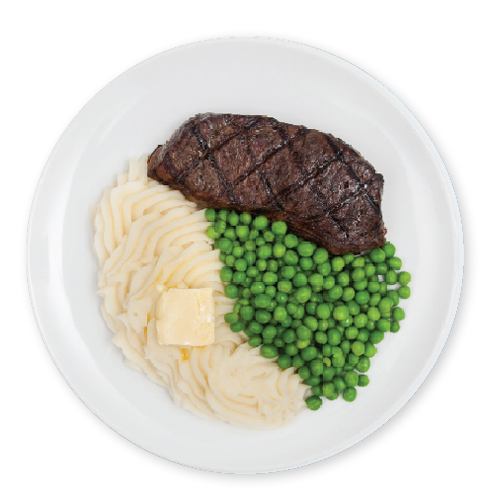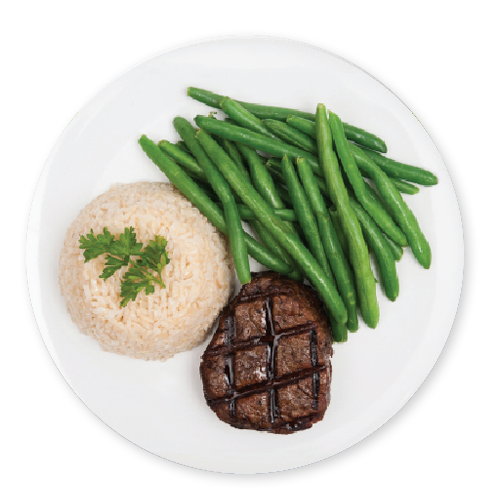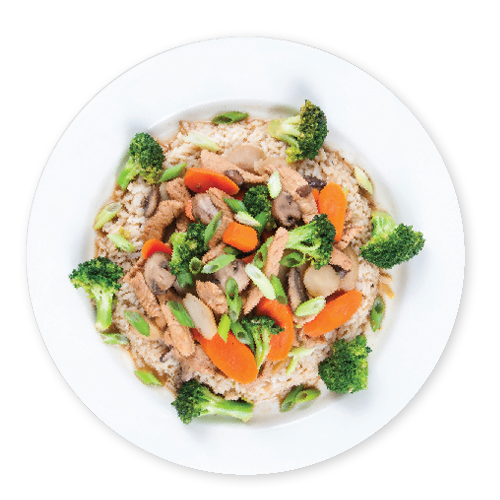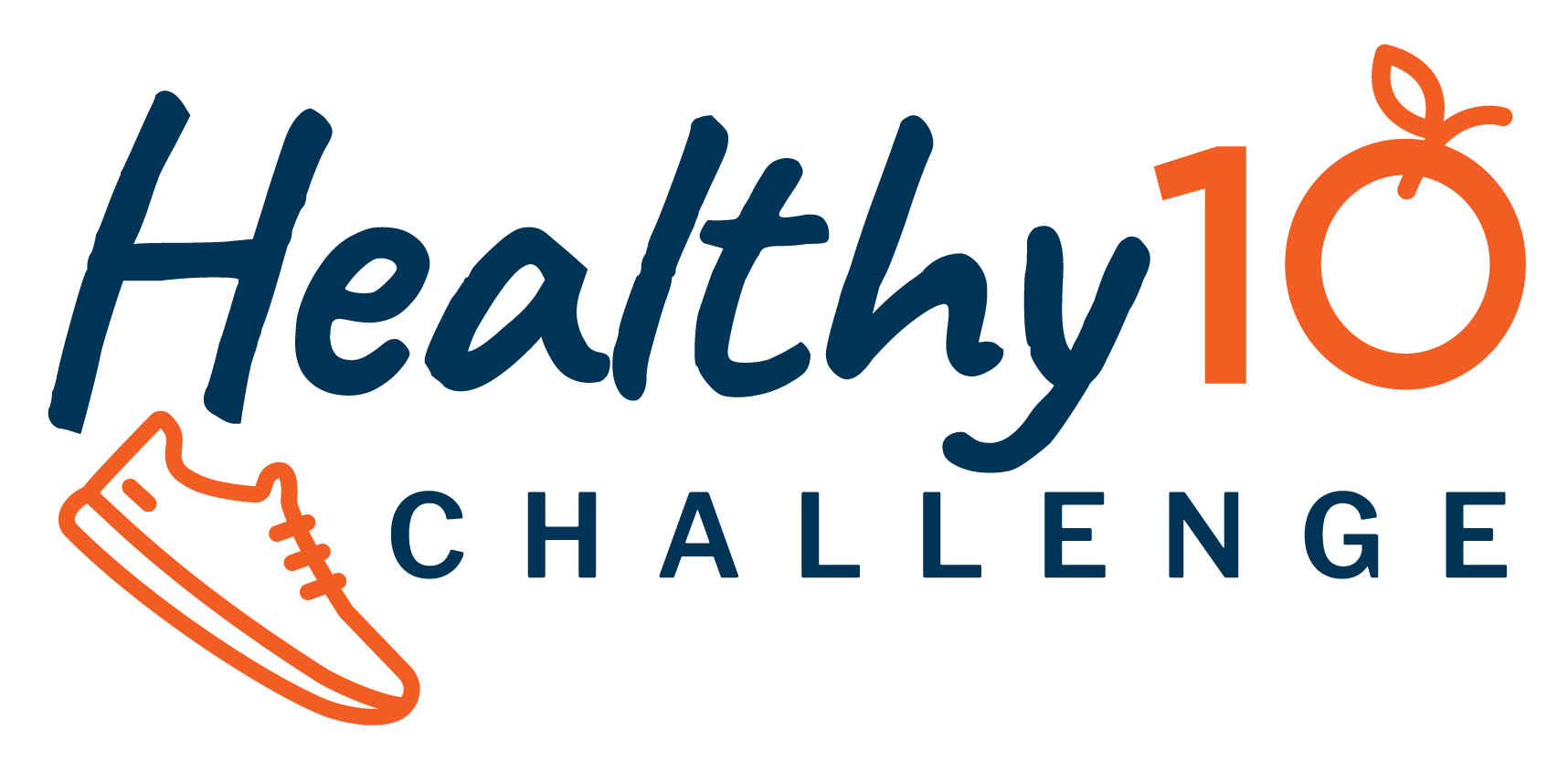Delicious and fortifying, this scientifically sound eating philosophy lets you enjoy incredible meals, while emphasizing foods that promote health to reduce your risk for cancer and other chronic diseases.
Too often, the traditional American plate is not a healthy meal. Many Americans rely on fast food or processed food. A typical home-cooked dinner is often planned around a large portion of either red meat or poultry, with some potatoes or other starchy vegetable on the side, and sometimes a small serving of a green or non-starchy vegetable. Meals like these often contain too many calories, and not enough health-protecting vitamins and minerals.
At the center of the New American Plate is a variety of vegetables, fruits, whole grains, and beans. These foods are rich in fiber, vitamins, and other natural substances called phytochemicals that help keep you in good health, and protect against cancer. They are also naturally low in calories.
Ready to eat better and move more, but need a little support?
Join AICR’s new Healthy10 Challenge today! This is a free 10-week interactive online program to help you improve your diet, nutrition, physical activity and weight for lower cancer risk and better overall health. The challenge includes two major components—nutrition and physical activity—that will help you eat smarter and move more. Each week you will receive a new challenge along with tips and tools to help you conquer the challenge. Each challenge is based on AICR’s 10 Cancer Prevention Recommendations.
What’s the focus of the New American Plate?
The keys to the New American Plate are simple: portion and proportion.
Rather than overload your plate with big servings and centering eating around meat, the New American Plate helps you plan meals that are filling, well-balanced, and packed with nutritional value.
The goal is to have vegetables, fruits, whole grains and beans make up 2/3 (or more) of each meal, and animal protein to make up 1/3 (or less). This shouldn’t be seen as a rigid diet, but as an opportunity to be creative and flexible with your meals!
The New American Plate should not be confused with the Dietary Guidelines for Americans (DGA). Though there is some crossover between the two, there are also some distinctive differences between DGA and AICR’s cancer prevention recommendations.
These meals will leave you pleasantly satisfied, and will help you maintain your weight, and take care of your overall health and well-being.
How to Transition to the New American Plate
We know that making extensive changes to your diet can be tough. It’s common to get used to your dietary habits, and transforming your approach to nutrition can be an effort.
You don’t have to change everything overnight though. You can move to the New American Plate gradually. Little by little, you’ll find new ways of eating, and if you stick with it, eventually you’ll likely find that following the New American Plate’s model becomes second nature.
Take it one step at a time. When adjusting your meals to include more plant-based foods, even small changes can provide real health benefits. Every new vegetable, fruit, or whole grain and lentil/bean contributes disease-fighting power. And all the calories you save may make a real difference to your waistline.

Stage 1: The Old American Plate
The typical American meal is heavy on red meat, fish and poultry. Take a look at this plate. Fully half is loaded with a huge (8–12 oz.) steak. The remainder is filled with a hearty helping of buttery mashed potatoes and peas. Although this meal is a home-style favorite, it is high in calories and low in phytochemicals and fiber. A few changes, however, will bring it closer to the New American Plate.

Stage 2: A Transitional Plate
Start by making your meat portions smaller. Our transitional meal features a more moderate (4–6 oz.) serving of meat. You then want to increase the size of your veg portion and reduce the size of your carbs portion. Again, in our example we’ve opted for a large helping of green beans prepared with your favorite herbs and the addition of a filling whole grain (seasoned brown rice). Making these changes increases the proportion of nutritious, plant-based foods. This plate is on the right track, but doesn’t yet take advantage of all the good-tasting foods the New American Plate has to offer.

Stage 3: The New American Plate
This meal is a great example of the New American Plate. To achieve this meal you’ll be opting for an ever smaller portion of meat. The modest 3-ounce serving of meat (fish, poultry, or red meat) pictured here fits AICR guidelines for cancer prevention. This plate also features a wider variety of foods, resulting in a diverse assortment of cancer-fighting nutrients. Rather than just a single portion, opt to include a wider range of vegetable types in your meals. Two kinds of vegetables increase the proportion of plant-based foods, and a healthy serving of a tasty whole grain (brown rice, barley, kasha, bulgur, millet, and quinoa) completes the meal.

Stage 4: Another Option
There are many ways your meals can fit the New American Plate template. Here’s another example. In a one-pot meal – like this stir-fry – you can reduce the animal foods and increase the plant-based ingredients without even noticing. Swap out some of the meat for vegetable alternatives. This plate is bursting with colorful vegetables and hearty whole grains, which are packed with cancer-fighting vitamins, minerals, and phytochemicals. Fish, poultry, or occasionally red meat is used as a complement, adding a bit of flavor and extra substance to the meal.
Switching to New American Plate
Whilst switching up your diet can feel like a daunting task, with little steps it becomes a much easier process. Dietician Barbara Spalding has made the transition and shares her thoughts on switching to the New American Plate.

A Blueprint to Beat Cancer
Cancer Prevention Recommendations
If you already follow the New American Plate model, then you’ve started making our Cancer Prevention Recommendations part of your everyday routine. Drawn from exhaustive research, these evidence based guidelines can help you make informed choices about your day-to-day health, and can help you ensure you’re doing everything you can to protect yourself from cancer.
Recipes that fit the New American Plate
Want to try some recipes that perfectly fit the New American Plate? Look no further, we have a range of healthy recipes that use cancer fighting ingredients to reduce the risk and help you live a healthier lifestyle.
Tips for switching your diet
Want some extra help to switch up your meals? Here are our tips for creating meals that fit the New American Plate.
- AICR’s New American Plate is an example of a plant-based diet created to reflect research on reducing cancer risk. It can include only plant foods if you want, or it can be a plant-focused diet that includes moderate amounts of animal-based foods.
- Aim for a variety of vegetables and fruits for the widest array of nutrients and protective phytochemicals.
- With the New American Plate, you have the framework for healthy eating choices and lots of flexibility to choose what’s convenient on a particular day, the people with whom you’re eating, what’s on sale at the grocery store or what you’re in the mood to eat. The focus on whole plant foods makes it easier to satisfy hunger with portions appropriate for you.
- If you include red meat (beef, lamb and pork), limit amounts to no more than 12 to 18 ounces a week. And be sure that it’s mostly unprocessed red meat (rather than processed meats like bacon, sausage, salami and hot dogs that pose greater cancer risk). For many people this guideline means limiting red meat to no more than three portions a week. However, some people choose to use portions no bigger than a deck of cards, and include small amounts of red meat in dishes combined with beans, grains and vegetables four to six times a
Foods That Fight Cancer
Want to learn more about specific foods and grocery items? The Institute’s detailed library of food facts can help you understand why specific foods are good for you, so you can make informed decisions about what you eat and drink.
The Cancer Prevention Research
AICR’s New American Plate is a plant-based diet created to reflect research on reducing cancer risk. It emphasizes choosing foods with plenty of fiber, nutrients and plant compounds that may help protect against cancer; limits foods that increase the risk of cancer; and helps reach and maintain a healthy weight, which research shows can play a major role in reducing cancer risk.
What does the data tell us?
AICR’s New American Plate is an inclusive approach that shows how to put into practice the recommendations to reduce cancer risk and promote overall health. Here are our insights into why the New American Plate has been found to help fight the development of cancer.
Opt for high-fiber
All plant foods are not the same. Limited evidence suggests that high-fiber diets rich in whole grains, non-starchy vegetables, and fruits reduce the risk of a wide range of cancers. Although evidence linking individual nutrients or types of foods with lower cancer risk is limited, combined as an overall eating pattern, these choices add up to reduce cancer risk.
Prioritise unprocessed foods
Including relatively unprocessed plant foods — whole grains, vegetables, fruits, beans and nuts — as at least 2/3 of each meal may offer cancer protection beyond the fiber these foods provide. In laboratory studies, nutrients and compounds in these plant foods can change the expression of tumor suppressor and other genes, and influence cell signaling pathways, inflammation, and self-destruction of abnormal cells.
Limit dairy and meat
Dairy products, poultry, fish or red meat – if included – are kept to no more than 1/3 of each meal. Red meat (beef, lamb and pork) is limited to no more than 12-18 ounces (cooked) per week because excess amounts increase risk of colorectal cancer. And on the New American Plate, red meat choices are most often unprocessed red meat. Even smaller amounts of processed meats (like bacon, sausage, salami and hot dogs) increase cancer risk, so save them for special occasions.
Avoid high-fat and sugary options where possible
Even though they’re technically plant-based foods, choices that are highly processed and contain a lot of fat and added sugar make it harder to maintain the healthy weight that plays a strong role in reducing the risk of at least 12 forms of cancer.
Source: AICR/WCRF. Diet, Nutrition, Physical Activity and Cancer: A Global Perspective, 2018.
Additional factors to be aware of
What you do eat, what you don’t eat, and overall lifestyle counts. Here are some additional factors to consider alongside transitioning to the New American Plate.
- Studies of plant-focused diets and their association with cancer risk sometimes show different results. A closer look suggests that part of the difference may reflect the importance of specific food choices and the context of the overall lifestyle.
- Eating patterns are an important part of a lifestyle to reduce cancer risk, and there’s much more you can do. Be physically active in some way every day, limit the time you spend sitting, aim to reach and maintain a healthy weight, limit alcohol, and of course, avoid tobacco in any form.
- The overall context of AICR’s New American Plate as part of a healthy lifestyle that also includes physical activity, matters. Independent studies from around the world show that the more closely you follow the AICR’s cancer prevention recommendations, the lower your risk of developing cancer.
References
- World Cancer Research Fund/American Institute of Cancer Research. Continuous Update Project Expert Report 2018. Recommendations and public health and policy implications. Available at dietandcancerreport.org.
- Scientific Report of the 2015 Dietary Guidelines Advisory Committee. Washington, DC.2015.
- Arnett D, K., Blumenthal Roger S, Albert Michelle A, et al. 2019 ACC/AHA Guideline on the Primary Prevention of Cardiovascular Disease. Circulation.0(0):CIR.0000000000000678.
- World Cancer Research Fund / American Institute for Cancer Research. Continuous Update Project Expert Report 2018. Wholegrains, vegetables and fruit and the risk of cancer. Available at: dietandcancerreport.org.
- World Cancer Research Fund/American Institute of Cancer Research. Continuous Update Project Expert Report 2018. Meat, fish and dairy products and the risk of cancer. Available at: dietandcancerreport.org.
- World Cancer Research Fund/American Institute of Cancer Research. Continuous Update Project Expert Report 2018. Diet, nutrition and physical activity: Energy balance and body fatness. Available at dietandcancerreport.org.
- Kohler LN, Garcia DO, Harris RB, Oren E, Roe DJ, Jacobs ET. Adherence to Diet and Physical Activity Cancer Prevention Guidelines and Cancer Outcomes: A Systematic Review. Cancer Epidemiol Biomarkers Prev. 2016.






